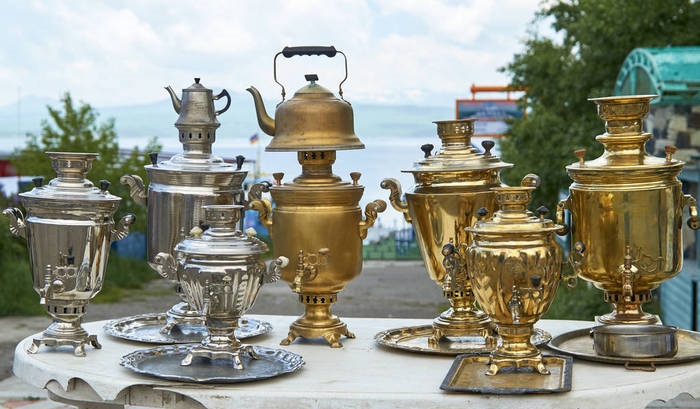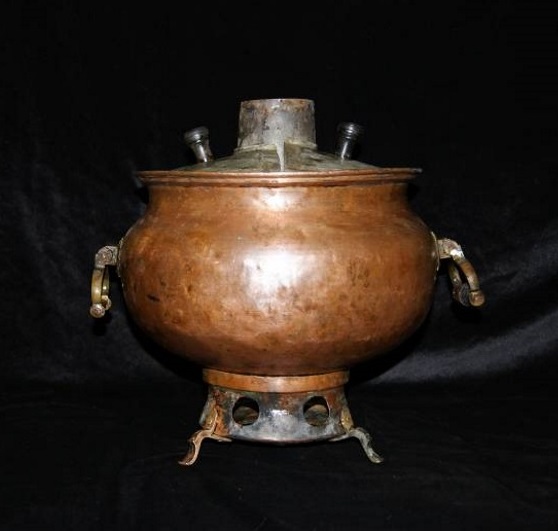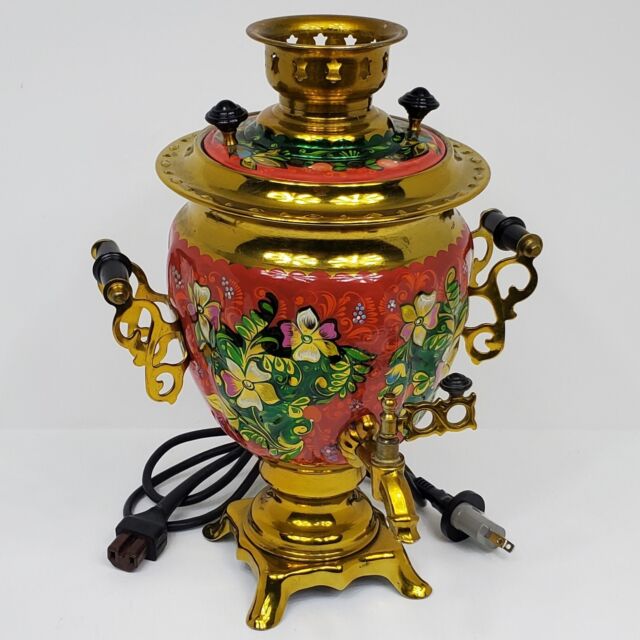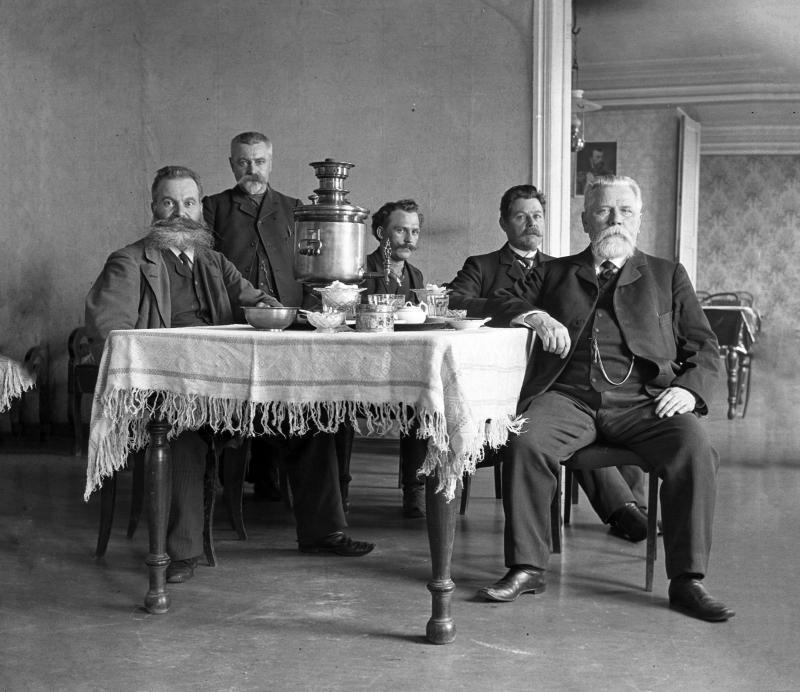How Russia Fell in Love with Samovars: The History of the Formation of a National Symbol
The samovar is a source of pride for Russian culture, a symbol of prosperity and hospitality. The first examples of samovars appeared in Russia in the 18th century, but even centuries later they continue to please the eye with their appearance and functionality.
The first Russian samovars were very similar to modern ones: it was a vessel with a tap that was heated by charcoal. The coal was placed inside a pipe that ran through the entire samovar. As the coal burned, the water inside the samovar began to boil. Due to their design, samovars quickly became popular among the population. They were easy to use and had an attractive appearance, which made them not only a useful household attribute but also a great gift for friends and relatives.

The history of the samovar in Ancient Greece and the East
Samovar-type devices for heating water and cooking food can be found in the history of many countries. Authepsa is an ancient device for heating drinks that was used in antiquity. The name of this device comes from the Greek word "αὐθέψης", which means "self-boiling" or "self-cooking". This reflects the main feature of the Authepsa - the ability to maintain the temperature of the drink without the need for constant monitoring.
Authepsa is a tall jug-shaped vessel with two containers inside. One of them is for liquid, and the other is for coal. The coal was loaded through a special side opening, and the liquid was poured in and out using a ladle, since the authepsa did not have a tap. The principle of operation of the authepsa is quite simple. The coal placed inside the vessel begins to burn, releasing heat. This heat is transferred to the liquid in the other container, maintaining its temperature. Thus, the authepsa allows you to keep the drink hot for a long time.

Interestingly, in hot weather, the autepsa could be used to cool drinks. To do this, the vessel was filled not with coal, but with ice, which was brought from afar. The ice, absorbing heat, cooled the liquid inside the autepsa. The autepsa was widespread in Ancient Greece and Rome. It was used both at home and in public places, such as taverns. This device was a convenient and practical solution for maintaining the temperature of drinks in conditions when heat conservation technologies were not yet sufficiently developed.
In China, samovar analogues have also been used since ancient times. Samovar-type vessels for boiling water, known as "hogo" or "tsibati", were widespread. They had all the basic design elements of a samovar: a vessel for water, a brazier for coals, and a pipe passing through the vessel. These devices were used not only for boiling water, but also for preparing various dishes.
Samovar-type devices have been found in excavations in Iran, Azerbaijan and other Middle Eastern countries. In Azerbaijan, in the area of the village of Dashust, during archaeological excavations, fragments of a clay samovar were found, the age of which is at least 3600 years.
Thus, although the samovar is considered a traditionally Russian attribute, its prototypes existed in many other countries, including Greece, Iran, China and Japan. These devices reflected the cultural traditions and customs of these countries, and also demonstrated common features in the methods of boiling water.
History of the samovar in Russia
One of the most famous legends says that the samovar was brought to Russia by Peter I from Holland. However, historical facts tell a different story. Indeed, Peter I made a great contribution to the development of industry and technology in Russia, but samovars appeared in the country only half a century after his death.
The first Russian samovars were made in the Urals. This is confirmed by documents from 1740, which mention a 16-pound tinned copper samovar made at the Irginsky plant. Thus, it can be argued that it was the Irginsky plant that became the birthplace of samovars in Russia. Tula, which is today considered a symbol of Russian samovar art, began producing these items much later. The first mention of Tula samovars dates back to 1746. But despite this, Tula quickly became the center of samovar production and retains this status to this day. It is important to note that samovar production was established not only in Tula. For example, production of these items began in Suksun at the same time. Some researchers even suggest that samovar production could have begun simultaneously in both places, since both plants belonged to the Demidov brothers.
Thus, the origin of the samovar in Russia has its own peculiarities and nuances. Despite the fact that Tula is today considered a symbol of Russian samovar art, history says that the primacy in the production of these items belongs to the Irginsky plant from the Urals.
Classification of samovars
The history of the samovar in Russia is rich and varied. One of the most interesting periods in the development of this item is the end of the 19th - beginning of the 20th century. During this time, significant changes occurred in the technology and design of samovars, which led to the emergence of new types and models.
One of these innovations was the appearance of kerosene samovars. The factory of the Russian citizen Reinhold Teile, founded in 1870, began producing these samovars along with the fire-type ones. Kerosene samovars found great demand where kerosene was cheap, especially in the Caucasus. Moreover, they became popular abroad as well.
Another interesting innovation was the Parichko samovar. Invented by Russian engineer Alfons Yulianovich Parichko, it was released in 1908 by the steam factory of the Shakhdat brothers' partnership and Co. This samovar had a unique device that made it fire-safe and allowed the water to stay hot longer. In addition, it was easy to clean and could run on various types of fuel, including alcohol. After the Revolution of 1917, samovar factories were nationalized, and in 1919, a state association of samovar factories was created in Tula. In 1922, samovar production was organized at the First State Copper Processing Plant in the city of Kolchugino, which is now known as ZAO TD Kolchug-Mitsar.
The Soviet era is notable for the fact that in 1956, the production of electric samovars was established in Tula. Electric samovars were easier and more convenient to use than fire samovars. New technologies were introduced in the production of electric samovars, which simplified the manufacturing process. For example, samovar handles were no longer riveted, but welded. Today, there are three main types of samovars: fire samovars, electric samovars, and combined samovars.

The fire samovar, also known as a coal or wood samovar, is the oldest and most traditional type of samovar. It heats water using a fire that is lit inside a special chamber. The fire samovar requires certain skills and abilities to use correctly, but it has a special charm and atmosphere.
An electric samovar is a modern version of a traditional device. It heats water using an electric heating element. Such a samovar is very convenient to use, as it does not require special care and maintenance. In addition, an electric samovar heats water faster than a fire samovar.
A combination samovar is a device that combines the advantages of both types described above. It can use both electricity and fire to heat water. A combination samovar is ideal for those who value tradition, but still want to be able to quickly and conveniently heat water.
Each type of samovar has its own advantages and disadvantages, so the choice depends on individual preferences and needs. It is important to remember that regardless of the type chosen, the samovar will always be a symbol of Russian hospitality and the warmth of the home.
- Комментарии
- Вконтакте











